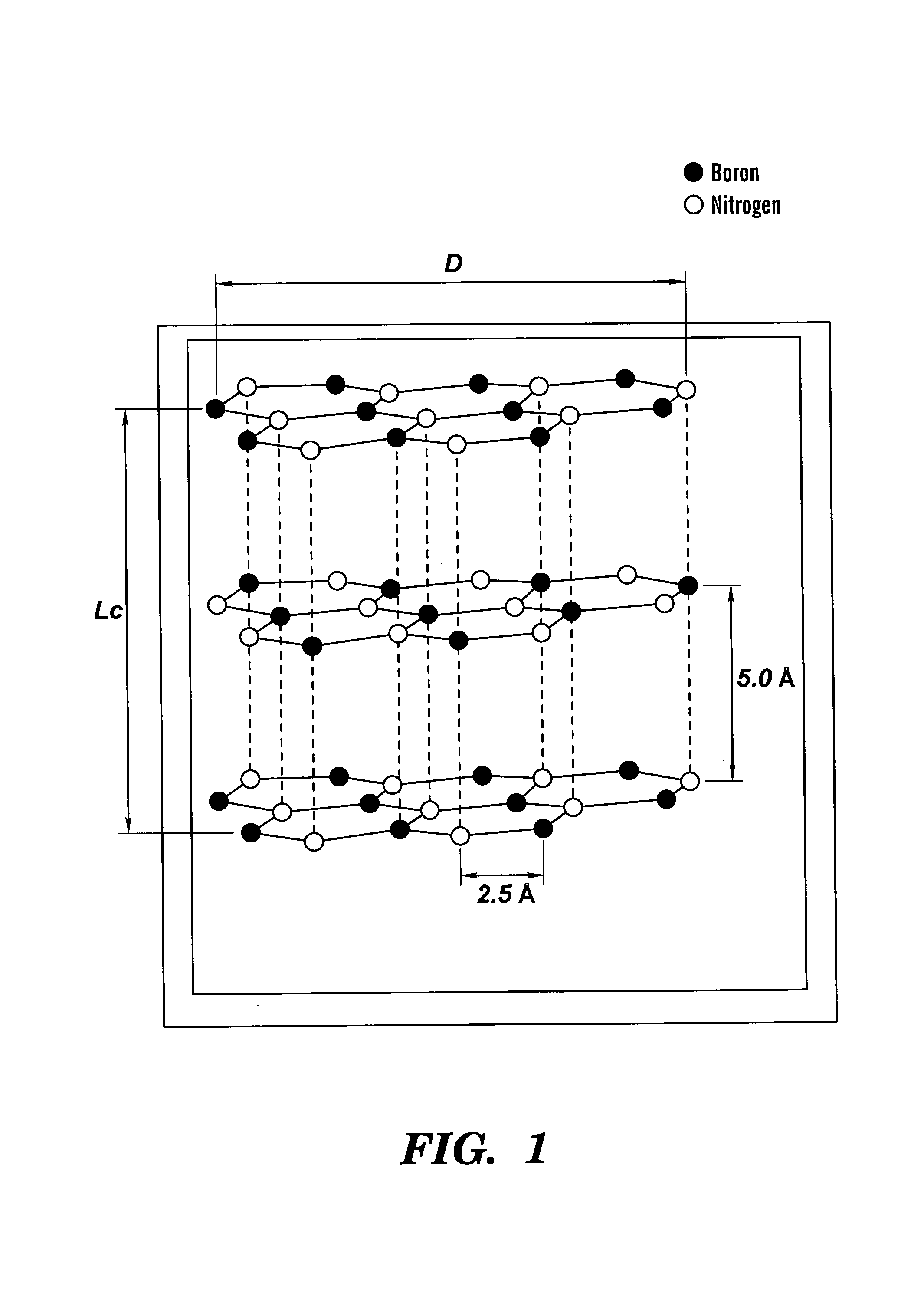Method for making high thermal diffusivity boron nitride powders
a boron nitride and high thermal diffusivity technology, which is applied in the field of making high thermal diffusivity boron nitride powders and the resulting powders, can solve the problems of increasing the electrical current used by these integrated circuit chips, limiting the effective heat removal capability of the heat sink, and increasing the size and power of the integrated circuit chips. , to achieve the effect of high thermal diffusivity, high thermal conductivity and high thermal diffusivity
- Summary
- Abstract
- Description
- Claims
- Application Information
AI Technical Summary
Benefits of technology
Problems solved by technology
Method used
Image
Examples
example 1
Preparation of Boron Nitride (BN) Powder Using Low Surface Area BN Starting Material
[0036]Boron nitride having a surface area of 2 to 4 m2 / g, an average agglomerate size less than 210 microns, a primary platelet size of 6 to 12 microns, an oxygen content of less than 1%, and a B2O3 content of less than 0.1%, was isopressed at 20 ksi into a compacted form (all experiments described herein were repeated twice). The compacted form of boron nitride had a green density of between 1.66 and 1.70 g / cc. The thermal diffusivity was measured by laser flash technique (using an Appollo Laser, Model M22) and was found to be between 0.085 and 0.14 cm2 / sec. The compacted green bodies were then sintered at 2000° C. for 0.5 to 2 hours. The density of the sintered body was found to have decreased to 1.42 to 1.55 g / cc. The thermal diffusivity was measured again by the same technique and found to have increased to 0.182 cm2 / sec. The sintered body was then crushed in a roll mill (Model 666 “F” Gran-U-Liz...
example 2
Preparation of Starting BN Powder
[0037]A submicron, dried, filter cake made up of boron nitride powder synthesized at temperatures below 1400° C. (see, e.g., Paine et al., “Synthetic Routes to Boron Nitride,”Chem. Rev., 90:73–91 (1990), which is hereby incorporated by reference) was heat-treated at approximately 2000° C. for about 12 hours. The resulting sintered born nitride powder cake had a bulk density of about 0.85 g / cc, a surface area of between 2 and 4 m2 / g, and an oxygen content of less than 0.5 wt. %. The cake was subsequently roll crushed to two types of powder: agglomerates ranging from 30 to 700 microns and fines less than 30 microns. These powders served as BN starting material for sintering.
example 3
Preparation of BN Powder Using Fines Starting Material
[0038]The fines of Example 2 were isopressed at 20 ksi resulting in a compacted form having a green density of 1.74 g / cc. This green compacted form was then sintered at about 2050° C. for about 2 hours, after which the sintered density was measured to be 1.60 g / cc. The tap density of the powder prepared by roll crushing and classifying to an agglomerate size distribution between 30 and 105 microns was found to be approximately 0.83 g / cc.
PUM
| Property | Measurement | Unit |
|---|---|---|
| Length | aaaaa | aaaaa |
| Size | aaaaa | aaaaa |
| Size | aaaaa | aaaaa |
Abstract
Description
Claims
Application Information
 Login to View More
Login to View More - R&D
- Intellectual Property
- Life Sciences
- Materials
- Tech Scout
- Unparalleled Data Quality
- Higher Quality Content
- 60% Fewer Hallucinations
Browse by: Latest US Patents, China's latest patents, Technical Efficacy Thesaurus, Application Domain, Technology Topic, Popular Technical Reports.
© 2025 PatSnap. All rights reserved.Legal|Privacy policy|Modern Slavery Act Transparency Statement|Sitemap|About US| Contact US: help@patsnap.com


